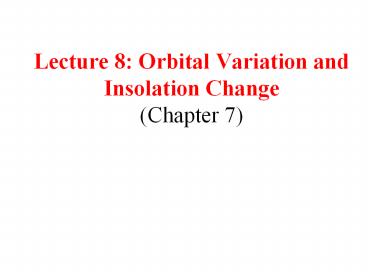Lecture 8: Orbital Variation and Insolation Change (Chapter 7) - PowerPoint PPT Presentation
Title:
Lecture 8: Orbital Variation and Insolation Change (Chapter 7)
Description:
... 0ka 11ka Modulation of Precession Index by Eccentricity Precession ... (2) a simple climate ... (Chapter 7) PowerPoint Presentation PowerPoint Presentation ... – PowerPoint PPT presentation
Number of Views:189
Avg rating:3.0/5.0
Title: Lecture 8: Orbital Variation and Insolation Change (Chapter 7)
1
Lecture 8 Orbital Variation and Insolation
Change (Chapter 7)
2
Orbit Today
Earths revolution around the sun on the ecliptic
3
Tilt Effect
Tilt of the earths axis of rotation
4
Tilt and Season
Tilting and season
5
Extreme Tilts
Extreme tilt
6
Perihelion/Aphelion Today
Earths revolution around the sun on the ecliptic
7
Change of tilt
8
Eccentricity of the earths orbit
9
Change of Eccentricity
10
Precession of equinoxes (wobble and shift of
perihelion)
Perihelion
Aphelion
11
Precession of angle (between perihelion and
equinox axes)
12
Extreme Solstice (large eccentricity large tilt)
0ka
11ka
13
Modulation of Precession Index by Eccentricity
14
Precession Index Modulated by Eccentricity
15
Seasonal insolation
Where precession signal is large, why? Where
tilt signal is large, why? What signal is
dominant in the annual mean, why? What is the
phase of each signal, in different hemisphere?
10
16
Seasonal insolation
17
Insolation time series of different months
18
Calendar months (fixed-day) vs. Celestial months
(fixed-degree, or fixed-angular)
Apr, 1
May 1CelestialApr 1 30o
May 1CalenderApr 1 30 days
Jul 1CalenderApr 1 91 days
Jul 1CelestialApr 1 90o
Keplers laws equal area!
19
Calendar vs. Celestial months
126 ka (PH June) -- 0 ka (PH Jan)
126 -0 ka, Calendar month
0 ka
Celestial month
Calendar-Celestial
Starting Vernal Equinox
Chen et al., 2010, Clm Dyn
20
Caloric months (relative warmth)
Caloric summer is the 182 days of insolation
more than the other 182 days (Caloric winter)
21
Searching for orbital signal in climate records
simple
complicated
22
Milutin Milankovitch was a Serbian engineer and
meteorologist - born in 1879 he attended the
Vienna institute of technology graduating in
1904 with a doctorate in technical sciences. He
then went on to work in the University of
Belgrade where he spent time working on a
mathematical theory of climate based on the
seasonal and latitudinal variations of solar
radiation received by the Earth.
Milankovitch proposed that the changes in the
intensity of solar radiation received from the
Earth were effected by three fundamental
factors. The first is called eccentricity, a
period of about 100,000 years in which the nearly
circular orbit of the Earth changes into a more
elliptical orbit. The next factor is called
obliquity, a period of about 41,000 years where
the Earth's axis tilt varies between 21.5 and
24.5 degrees. The final factor is called
precession, a period of approximately 23,000
years where the Earth's axis wobbles like a
spinning top.
23
Milankovitch TheoryOrbital theory of glaciations
and climate model
Milankovitch(1920) (1) accurate calculations of
insolation change due to orbital changes
Sensitivity experiments Response of temperature
to changes in orbital parameters
- (2) a simple climate model
116 ka 11 ka
Koeppen and Wegner (1924) give
strong support to linking cool summers to
initiation of glacials
24
Rejection of Orbital Theory
Simpson (1940)
Simpson reported LARGE summer temperature
charges And LARGE winter temperature changes,
but he concluded that these extremes cancelled
in the annual average. Therefore Milankovitchs
idea was unimportant.
25
New observations from marine sediments resurrect
Orbital Theory
Hays, Imbrie and Shackleton, 1976
Marine observations
Spectra with orbital period peaks
26
Power spectral analysis Proof of orbital
forcing!
but, relative magnitude ?
27
Spectral analysis
Fourier analysis
where
is the power (amplitude) at frequency
or period
28
Power spectral analysis Proof of orbital
forcing!
but, relative magnitude ?
29
Undersampling!
30
Homework set 3
- Insolation forcing
- Power spectrum
31
End of Lecture 8
32
(No Transcript)
33
(No Transcript)
34
(No Transcript)
35
(No Transcript)

